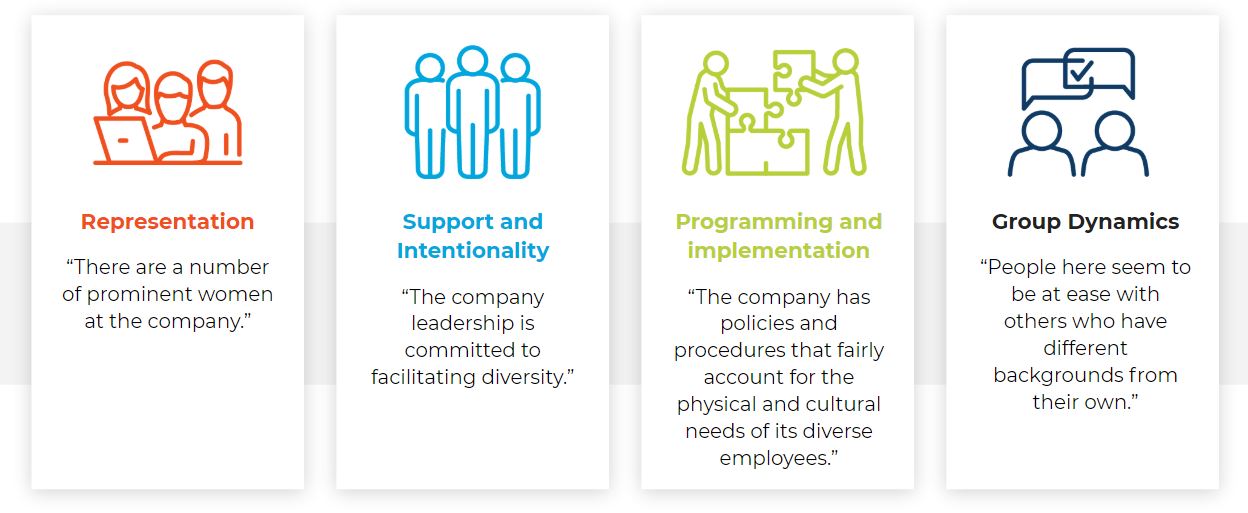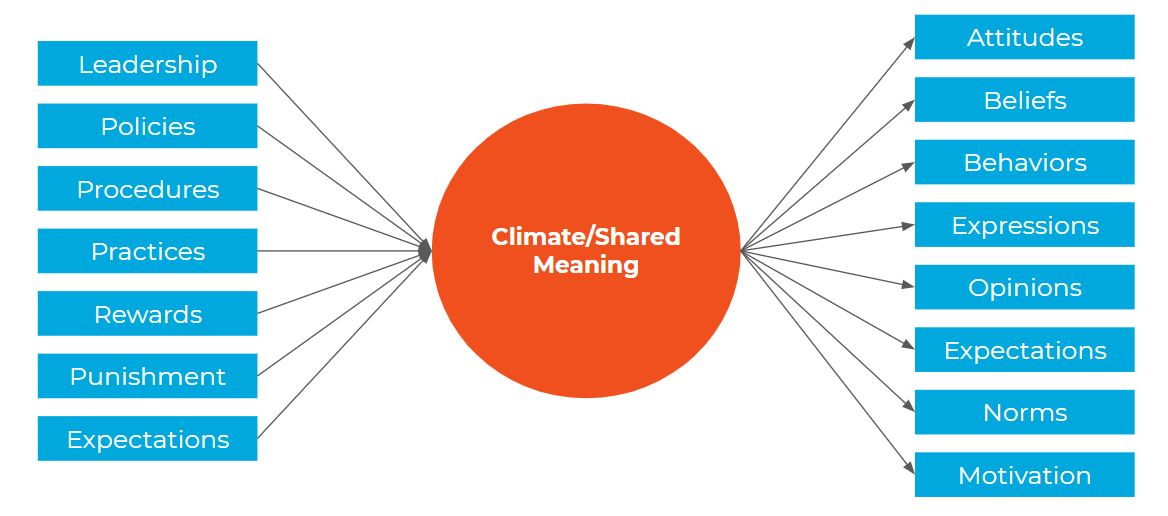Climate surveys go beyond workforce stats to tell you critical information about employee perceptions and the signals your organization is sending. In this article, Principal Consultant Patrick McNiel, PhD explores how this powerful analytical tool can be brought to bear on diversity and inclusion, and what you can do with what you learn.
While simple demographic data can give you some insight into the state of diversity and inclusion in your organization, the numbers you uncover are unlikely to give you a complete picture of how the D&I measures you take are perceived by employees.
By using climate survey methodology, you can ‘take the temperature’ of your work environment and understand your present, future, and potential diversity and inclusion performance, and plan accordingly.
A positive climate for diversity and inclusion is highly desirable. It relates to attributes such as performance, customer satisfaction, creativity, productivity, psychological safety, and return on investment, especially when diverse people are involved. Changes to climate that endure have the potential to positively impact your culture—by its nature difficult to measure and change—and alter employee attitudes, behaviors and expectations.
See it in practice: ‘How the U.S. Olympic Committee Measures Diversity Success’
Climate Survey Basics
Every organization has multiple climates that are measurable on multiple scales, and each of these could be a candidate for study. You may be more familiar with certain types of climate studies than others, but in terms of broad categories, we can split them into two main types:
- Molar climate studies measure the overall positive (or negative) sense of the work environment and its effect on employees across the full breadth of the organization or in sub-areas of the organization.
- Focused climate studies can involve more elaborate models and measure aspects of climate that are relevant to some specific areas of concern. Examples include an organization’s safety, ethics, performance, customer service, or innovation climates. A study on diversity and inclusion in an organization would be considered a focused climate study.
Though focused climate studies have the potential to be more incisive and useful in addressing specific problems, a molar climate study is often still desirable. If everyone has a negative opinion of the organization, it can be difficult for the organization to facilitate various positive focused climates.
Organizational climates are neither static, nor are they necessarily consistent from one department or team to the next. For this reason, it can be useful to conduct different surveys periodically (at least annually) and to modify the design of those studies based on previous results and on your current end-goals.
More from the blog: ‘Answering 11 Questions That Will Help You Use Data to Improve and Advance Your D&I Program’
Characteristics of Your Diversity and Inclusion Climate
An organization’s diversity and inclusion climate is, like other climates, the shared meaning organizational members attach to the events, policies, practices, and procedures they experience and the behaviors they see being rewarded, supported, and expected. So, shared meaning is derived from signals that are relevant to a particular climate. Some examples of common D&I signals include:
- The stated (and visible) importance of diversity
- Specific diversity initiatives the organization has enacted
- Inclusive attitudes encountered across the business
- Inclusive language used by the organization and its employees
- Inclusive behavior, and expectations of people’s behavior to each other
An organization’s climate for diversity and inclusion can be divided into four main areas that are helpful to keep in mind when designing a study. These are:
- Diversity Climates: Those climates relevant specifically to Diversity
- Inclusion Climates: Those climates relevant specifically to Inclusion
- Pre-Requisite Climates: Aspects that need to be in place for strong and sustainable D&I climates
- Support Climates: Aspects that can help or hinder the formation of positive D&I climates
These areas can then be further subdivided, as below, and each subdivision can be measured with a specific set of questions.
You might also like: ‘Diversity & Inclusion in High Tech: 3 Key Strategies for Promoting an Inclusive Workplace’
1. Diversity Subclimates
The diversity climate in an organization can be derived from four main areas that we will refer to as representation, support and intentionality, programming and implementation, and group dynamics.

i) Representation
Do individuals see diversity across jobs and levels and think of the company as diverse? Note that a negative sense of representation can exist even if on paper a company has good representation—the visibility of diverse individuals also matters.
Typical question prompt: “There are a number of prominent women at the company.”
ii) Support and Intentionality
Do individuals interpret the leadership, their peers, and HR as actively wanting diversity, pushing for it, and supporting it in employees? Many organizations have a stated intention to support diversity, but a negative climate for diversity may still exist if they fail to follow through.
Typical question prompt: “The company leadership is committed to facilitating diversity.”
iii) Programming and Implementation
Do individuals interpret the policies, processes, and procedures at the organization as promoting and supporting diversity? It’s important to assess programs you implement and ensure that they’re interpreted positively and considered fit for purpose.
Typical question prompt: “The company has policies and procedures that fairly account for the physical and cultural needs of diverse employees.”
iv) Group Dynamics
Are those who are from different backgrounds treated with respect, consideration, and fairness? Furthermore, is diversity seen as an asset, and is the prevailing attitude pro-diversity?
Typical question prompt: “People here seem to be at ease with others who have different backgrounds than their own.”
2. Inclusion Subclimates
Inclusion can be divided into two principal areas: belonging and inclusion, both of which are needed for a truly inclusive climate.
i) Belonging
Do people have a sense of warmth when they go to work, do people like each other, and do individuals in the organization at large make each other feel like they belong? A sense of belonging is an important part of inclusion and can prevent isolation and a lack of investment in common goals.
Typical question prompt: “People here feel like they are an integral part of their workgroups.”
ii) Inclusion
Are people allowed to be themselves, or do they have to put on a false front at work? A negative inclusion climate may result if a sense of belonging is contingent on inauthenticity. In other words, if a worker has to change how they act in order to fit in.
Typical question prompt: “People here encourage each other to present themselves the way they are.”
Related reading: ‘Workforce Diversity Series: 4 Ways to Build a Diverse Organization’
3. Pre-Requisite Subclimates
There are strongly related climates that, when negative, will have an adverse effect on the climate for diversity and inclusion. These are an organization’s justice climate, trust climate and molar climate.

i) Justice Climate
Your organization’s justice climate has several components (with typical question prompts in italics):
- Distributive: Whether compensation, rewards, and resource distribution is considered fair and equitable (“Rewards here are distributed fairly”).
- Procedural: Whether policies and procedures are perceived as biased or unequal (“At the company, HR systems and processes are applied equitably to all employees”).
- Interpersonal: Whether there is fairness in conduct between people, leaders and employees (“Harassment at the company is not tolerated”).
- Informational: Whether information is equally distributed and accessible (“Leadership here is candid in its communications with employees”).
A negative justice climate has considerable power and can override any diversity and inclusion signals. The classic example would be an organization running a wide range of diversity initiatives, fostering togetherness and authenticity while still paying its women employees less than similarly qualified men.
ii) Trust Climate
Trust climate is the general sense within a group that people can rely on one another, have each other’s backs, and act with integrity. One of the main reasons diversity and inclusion are important topics is because humans have tribal natures that tend to divide the world into various ingroups and outgroups, and doing so erodes trust between those groups.
Trust occurs between people when they perceive each other to be on the same side and working toward the same overall goals. Without a positive trust climate, it’s much more difficult for people to be inclusive and to believe in the intentions and actions of leadership with regard to diversity efforts.
Typical question prompt: “Leadership at the company is good, which helps our future success.”
iii) Molar Climate
As previously mentioned, a negative molar climate can undermine your diversity and inclusion climates. When people have a negative perception of the organization, they are more likely to become fixated on inequities and unfairness, as well as to question motives and generally act without collective interests in mind.
4. Support Climates
Finally, the last of the four areas includes those climates that have a potentially supportive effect on your diversity and inclusion climates.
- Openness to experience: When your organization and its employees are open to experiences, it’s easier to explore new ideas, examine information, and appreciate and utilize differences to best effect.
- Psychological safety climate: Positivity in this climate leads to a constructive approach to mistakes made, less fear associated with risks taken, and a readiness to seek support. This climate is highly related to trust in the organization and can lead to better engagement.
- Support climate: A climate of support is characterized by the sense that leadership cares for employees as well as their job performance, that needed direction, resources, and training will be provided, and that thought will be put into work-life balance issues. The effort, communications, and thought needed to establish such a climate sends signals to employees that their work matters, that they matter, and that the work cannot be done without them.
Handpicked for you: ‘Moving the Needle on Strategic Diversity: 6 Steps to Advance Your D&I Program’
How to Use D&I Climate Information to Improve Your D&I Efforts
In order to probe the many areas of your organization’s climate for diversity and inclusion, as described above, you will need a tailored suite of questions to gain the insights that will help you to achieve your D&I goals. Expert assistance in choosing or developing these questions is of course recommended—but an understanding of the climates and subclimates involved will also make it easier for you to interpret the data you get and implement its findings.
Once you have a complete study, you should be able to start forming a picture of where resources need to be redistributed. For example, you could find a positive inclusion climate, but see a negative response in terms of representation of diversity (for example, women are not seen in powerful positions).
Acknowledging this situation, you could then:
- Redirect resources away from inclusion initiatives to focus specifically on the visibility of women in power and investigations into their mobility in the organization, or
- You could work to leverage the climate of inclusiveness you have already built and focus on gender issues and mentorship programs that are more inclusive of women.
If you are ready to begin creating your own D&I climate investigations, contact us to talk to an expert today.
 About the Author
About the Author
Patrick McNiel, PhD, is a principal business consultant for Affirmity. Dr. McNiel advises clients on issues related to workforce measurement and statistical analysis, diversity and inclusion, OFCCP and EEOC compliance, and pay equity. Dr. McNiel has over ten years of experience as a generalist in the field of Industrial and Organizational Psychology and has focused on employee selection and assessment for most of his career. He received his PhD in I-O Psychology from the Georgia Institute of Technology.
